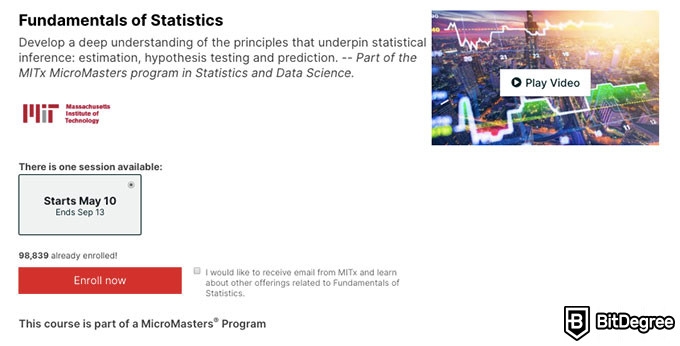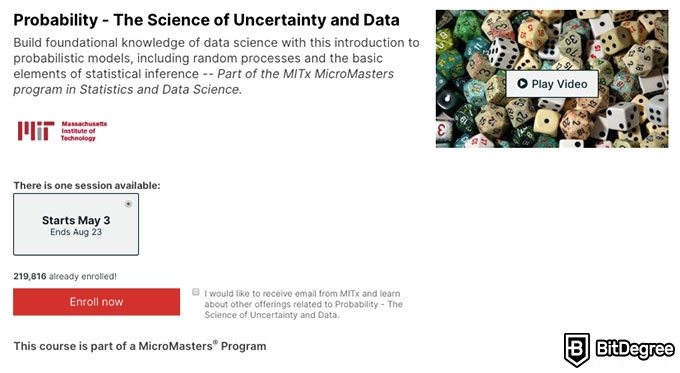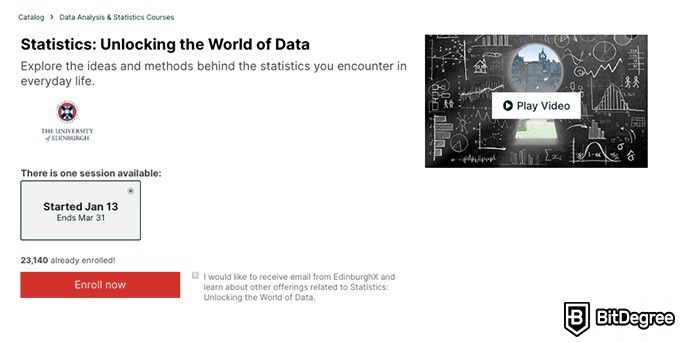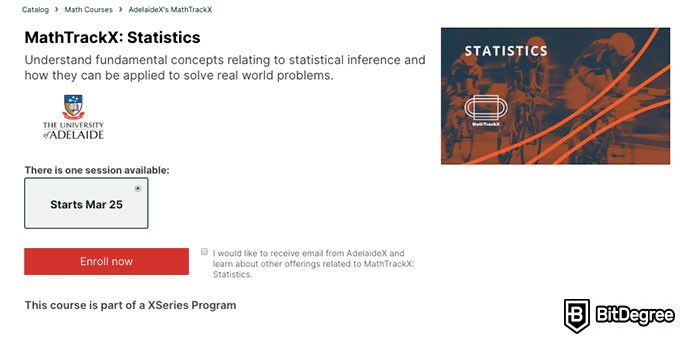Stop overpaying - start transferring money with Ogvio. Sign up, invite friends & grab Rewards now! 🎁
Here’s something interesting: 0.3% of solar energy from the Sahara is enough to power the whole of Europe. Pretty crazy, am I right? We wouldn’t be able to have this estimation if it wasn’t for the field of statistics. Now you can step into this world from wherever you are - the MIT statistics course is 100% online and it’s open to all.
With so many different courses online, it can be tough to choose the right one. So today I’ll provide you with all the necessary information about the MIT statistics course in fundamentals and also mention a few other courses you can take to build those statistics skills and knowledge.
Table of Contents
- 1. MIT Statistics Course: What Is Statistics?
- 1.1. Statistics vs Data Science: What’s the Difference?
- 1.2. Is Statistics a Good Career?
- 1.3. Where Can I Work as a Statistician?
- 2. MIT Open Courses
- 2.1. MIT Open Course: Statistics
- 2.2. Fundamentals of Statistics Course (Enroll Here)
- 3. MIT Statistics Course: edX Complementary Courses
- 3.1. Data Analysis for Social Scientists Course (Enroll Here)
- 3.2. Probability - The Science of Uncertainty and Data Course (Enroll Here)
- 4. Beginner-Friendly Courses
- 4.1. Statistics: Unlocking the World of Data Course (Enroll Here)
- 4.2. MathTrackX: Statistics Course (Enroll Here)
- 5. Final Verdict: Should I Take the MIT Statistics Course?
- 6. Conclusions
MIT Statistics Course: What Is Statistics?
Before we look at specific courses in more detail, I would like to explore statistics as a subject a bit more. Whether you’re passionate about statistics or simply need statistics skills for where you want to go next, there are some things you may not have realized about it before.
Latest DataCamp Coupon Found:The sciency definition of statistics is this: “[it’s] the mathematical science involved in the application of quantitative principles to the collection, analysis, and presentation of numerical data.” In other words, statistics are facts consisting of numbers, obtained from analyzing information.
Statistics usually examines a sample of the population, which can be a group of people, things, or any other objects under study, in order to gain information about the larger population. It helps us understand the world better and use math to answer questions and solve problems.
Statistics vs Data Science: What’s the Difference?
They share many similarities, however, there are some key differences to be aware of. Both Statisticians and Data Scientists work with data to extract some sort of information.
What makes the two different are modeling processes, the size of their data, the types of problems studied, the background of the people in the field, and the language used. Having said that, statistics is a fundamental tool used by data scientists.
Is Statistics a Good Career?
So perhaps you’re fascinated by numbers and you’re ready to dive into statistics, but doubts sometimes come to mind: how marketable are statistics skills? Will it really help me get a job?

Well, let me tell you something: statistics is everywhere. Statistician’s skills are essential for many industries and job roles. While you may not come across an open position titled “statistician” very often, you’ll find that many analytical positions require some level of statistics skills.
In 2023, the amount of data we generate is growing fast, and the world needs more and more specialists who can make sense of it. According to the Bureau of Labor Statistics reports, the demand for statisticians and mathematicians is expected to grow by 33% from 2016 to 2026[3].
Where Can I Work as a Statistician?
Statistics skills can be applied to a number of different fields that benefit from analyzing data to solve problems and answer all kinds of questions. Below you’ll see a list of different areas where statistics is used.
Business and Industry
Many companies use statistical models for quality control and quality assurance in manufacturing of goods across different industries, and who else can do a better job in this than a statistician?
Marketing is another area in business where statistics skills are highly valued. Through working with data, businesses can get a better understanding of customers preferences, trends and design products that are more likely to be successful.

In engineering, statistical models are used to minimize waste, defects, predict product life-cycles, and so on. They’re an important tool that helps improve existing and developing designs[1].
Health and Medicine
Statistics is an absolutely crucial part of health and medicine. Data gathered from statistical health analysis directs research and helps to decide how funds are distributed[2].
Education
Statistics can help measure the effectiveness of various teaching methods and compare different findings among different geographical areas or segments of a population. In turn, statistical information can contribute to the quality of education by allowing informed decision-making, based on real data.
Government
Statistics also lie behind many government decisions, regulations, and policies. Statistical methods are used in determining stock trading rules, air purity standards, new drug approvals, court proceedings, elections, and many more areas.
Social Sciences
This field is related to human behavior, and statistics have an important role to play here. It helps evaluate the quality of services available to a particular segment, objectively analyze behavior of groups of people in their environment and special situations and determine the wants of people through statistical sampling.

Guess what? That’s not all, I won’t go into too much detail about these to save you some reading time, but apart from what I’ve already talked about, statistics is also used in these areas:
- Research
- Natural Resources
- Psychology
As you see, there are many applications of statistics across various fields and industries. Of course, different statistical methods will be applied for particular fields, however it’s all statistics, no matter how you look at it!
If you’re interested to learn more, check out this list of different fields of application of statistics.
All right, now that you’re aware of just how versatile statistics skills can be, let’s look at how you can acquire them!
MIT Open Courses
MIT open courses are basically 100% online courses aimed at unlimited participation and open access, organized by the Massachusetts Institute of Technology.
You can find MIT open courses on edX, one of the best e-learning platforms right now. edX is a joint effort of MIT and Harvard University, which was brought to life in 2012. Today, it’s one of the most popular online open course providers, offering 2650 courses from many well-known universities and institutions.
“MIT open courses statistics” is a popular choice among online students. After all, Massachusetts Institute of Technology is considered the #1 university in the world, with only a 6.7% acceptance rate.

MIT open courses give students an opportunity to access quality content and learn from MIT instructors at an affordable price, independent of location. In fact, you can access many of the courses on edX for free! You can explore other available courses on this platform here.
All right! It’s time to look at the MIT statistics course in fundamentals, what it has to offer, the good and the bad, and explore some complementary “mit open course statistics” options.
MIT Open Course: Statistics
There are a few courses by MIT that involve statistics, including the MIT Probability and Statistics Course on edX. They’re marked as advanced-level courses, and there are some prerequisites, so if you’re a beginner, you might want to check out some lower-level courses first. I'll tell you more about those down below.
Visit this website to see what other courses are available in statistics on edX.
Right now, I’m going to tell you about the MIT statistics course that is based only on that - statistics. After that, I’ll tell you about two other courses by MIT, as well as the MIT probability and statistics course.
Fundamentals of Statistics Course (Enroll Here)

- Platform: edX
- Offered by: Massachusetts Institute of Technology
- Duration: 〜 18 weeks (10-14 hours/week)
- Price: FREE
- Certificate: YES (paid)
- Where to apply? Here
This is an advanced-level course provided to you by the Massachusetts Institute of Technology taught by three MIT instructors: Philippe Rigollet, Karene Chu, and Jan-Christian Hutter.
As the name suggests, this MIT statistics course covers the fundamentals in statistics. Make no mistake though, fundamentals in this case doesn’t mean ‘easy’ content. Previous students describe this course as a challenging yet rewarding course which requires a substantial amount of effort, but hey, you and I know: the roots of education are bitter, but the fruit is sweet.
In this MIT statistics course, you’ll develop an in-depth understanding of the core concepts and beyond: from the construction of estimators and tests to visualizing high-dimensional data.

Some of the more advanced questions you will cover are: how suitable is a given model for a particular dataset? How to select variables in linear regression? How to model nonlinear phenomena? How to visualize high-dimensional data?
The estimated time to complete the course is 18 weeks if you put in from 10 to 14 hours of work per week. Keep in mind that it’s an estimation, a lot will also depend on how much effort you put in, so it might take you a bit less or a bit more to complete the course. Every student is different, and that’s okay!
Teaching content is organized by video lectures that focus on one subject at a time. Other resources and tools in this MIT statistics course to help you learn are various exercises, recitation videos, and homework you’ll have to complete.

What you’ll learn:
- Construct estimators using method of moments and maximum likelihood, and decide how to choose between them
- Quantify uncertainty using confidence intervals and hypothesis testing
- Choose between different models using goodness of fit test
- Make prediction using linear, nonlinear and generalized linear models Perform dimension reduction using principal component analysis (PCA)
It’s not an entirely self-paced course. This particular MIT statistics course is instructor-led, which means there will also be specific deadlines you’ll have to meet.
This can be a huge advantage for an online course, because studying from home requires all of your motivational resources - at least to take that first step getting from the coach to your desk and logging into the course.
As I mentioned, this course covers some advanced material, therefore you must have experience in certain topics.
Prerequisites:
- 6.431x or equivalent probability theory course
- College-level single and multivariable calculus
- Vectors and matrices
This MIT statistics course is part of the MITx MicroMasters Program in Statistics and Data Science, also available on edX. So, if you want to take it a step further - by all means!
Oh, and before I forget, here’s a little secret: you can access the Fundamentals of Statistics Course for free! Does taking a MIT course for free sound too good to be true? Well, you better believe it!
The only condition is that you don’t get a certificate unless you purchase it. However, it doesn’t stop you from gaining all that knowledge! Plus, you can always enroll, see if you really like the course, and if it hits the spot - decide whether you need a certificate later.
To sum it all up, this MIT statistics course is an advanced course, packed with valuable content and tools that can transform your statistics knowledge in a relatively short amount of time. It’s instructor-led, which means deadlines. You can access it for free, or purchase a certificate if you decide you need one.
MIT Statistics Course: edX Complementary Courses
There are some other MIT courses that involve statistics on edX. They’re different from the MIT statistics course we looked at, because they are also concerned with topics other than statistics, but you never know, maybe you’ll find something here that will pique your curiosity!
Data Analysis for Social Scientists Course (Enroll Here)

- Platform: edX
- Offered by: Massachusetts Institute of Technology
- Duration: 〜 11 weeks (12-14 hours/week)
- Price: FREE
- Where to apply? Here
You could say this is a MIT statistics course for future social scientists, but it will also benefit anyone who’s interested in statistics in other fields. It’s designed to teach students the fundamentals of probability and statistics and provide them with techniques for modern data analysis.
The techniques you’ll study include estimation, regression and econometrics, prediction, experimental design, randomized control trials (and A/B testing), machine learning, and data visualization.
What you’ll learn:
- Intuition behind probability and statistical analysis
- How to summarize and describe data
- A basic understanding of various methods of evaluating social programs
- How to present results in a compelling and truthful way
- Skills and tools for using R for data analysis
The good thing about this MIT statistics course is that no prior preparation in probability and statistics is required, though you should be familiar with algebra and calculus. The bad thing about this course is that it doesn’t offer a certificate, unless you enroll in the full MicroMasters Program that this course belongs to.
Before you enroll, check out the course preview. To access it, go to the course description on edX or click here.
The course preview is a chance for you to see what the course is all about, and the type of exercises you’ll be dealing with. Also, it includes some resources that you may find useful throughout the course, if you decide to complete it.
It belongs to two MicroMasters programs: the MITx MicroMasters Program in Statistics and Data Science and MicroMasters in Data, Economics, and Development Policy on edX.
Like other courses within the MicroMasters in Statistics and Data Science, this is an instructor-led course, meaning there are set deadlines that you cannot adjust whenever you like.
Probability - The Science of Uncertainty and Data Course (Enroll Here)

- Platform: edX
- Offered by: Massachusetts Institute of Technology
- Duration: 〜 11 weeks (12-14 hours/week)
- Price: FREE
- Certificate: YES (paid)
- Where to apply? Here
There isn’t a MIT Probability and Statistics Course that would focus on these two subjects specifically, however this course is pretty close. It’s an advanced course designed to teach students the basic notions and methodologies in probabilistic models and statistical inference that can be applied universally, including for statistics.
What you’ll learn:
- The basic structure and elements of probabilistic models
- Random variables, their distributions, means, and variances
- Probabilistic calculations Inference methods Laws of large numbers and their applications
- Random processes
The course also includes a unit on theorems and classical statistics, where you’ll cover topics like inequalities, convergence, the Weak Law of Large Numbers, The Central Limit Theorem (CLT) and introduction to classical statistics. If you’re looking to study MIT probability and statistics, this is may be the course for you.
It’s an instructor-led course, like others within the same MicroMasters Program. The whole content is divided according to units, with two to three lecture sequences per unit. This kind of course structure is great for students, because it allows them to focus on one thing at a time without trying to digest too much information all at once.
Prerequisites:
College-level calculus (single-variable & multivariable). Comfort with mathematical reasoning; and familiarity with sequences, limits, infinite series, the chain rule, and ordinary or multiple integrals.
Beginner-Friendly Courses
MIT statistics courses, including MIT probability and statistics on edX are advanced, so if you don’t have experience in this area, you may feel a bit disappointed, but there’s no need! There are many great lower-level courses on statistics on edX.
I’ll tell you about a couple that you can take for free and build foundational statistics skills in no time!
Statistics: Unlocking the World of Data Course (Enroll Here)

- Platform: edX
- Offered by: the University of Edinburgh
- Duration: 〜 8 weeks (4-6 hours/week)
- Price: FREE
- Certificate: YES (paid)
- Where to apply? Here
Finally a statistics course for beginners! This course picks it up right from the start and takes you through all the basics. You’ll understand the key concepts in statistics, make sense of data that’s presented to you, and learn to analyze and interpret data using interactive applets.
It seems that many statistics courses on edX are instructor-led, including this one. Well, that’s not a bad thing - strict deadlines, less slacking off!
What you’ll learn:
- Understand the key principles of statistics;
- Interpret and evaluate the kinds of data found in everyday life;
- Perform, and interpret results from, simple statistical analyses.
To enroll, you don’t need to have experience in statistics, however, some level of mathematics is advised, such as secondary school mathematics (GCSE/Standard Grade/National 5 grade C or above in Mathematics, or equivalent).
It’s a relatively short course, and you can take it for free. Whether you’re just stepping into the world of statistics or just refreshing your memory, it’s a good option, since there are no strings attached.
You can enroll, start the course, and pay nothing. You will only have to pay if you decide to purchase a certificate, which costs around $49 without a discount.

- Easy to use with a learn-by-doing approach
- Offers quality content
- Gamified in-browser coding experience
- Free certificates of completion
- Focused on data science skills
- Flexible learning timetable

- High-quality courses
- Nanodegree programs
- Student Career services
- Nanodegree programs
- Suitable for enterprises
- Paid certificates of completion

- A wide range of learning programs
- University-level courses
- Easy to navigate
- University-level courses
- Suitable for enterprises
- Verified certificates of completion
MathTrackX: Statistics Course (Enroll Here)

- Platform: edX
- Offered by: the University of Adelaide
- Duration: 〜 4 weeks (3-6 hours/week)
- Price: FREE
- Certificate: YES (paid)
- Where to apply? Here
Here’s another beginner-friendly course that will summon your inner statistician and help you build skills that you can apply in the real world. This is the last course from the MathTrackX XSeries Program, designed to equip students with in-depth maths knowledge and skills that can be applied in other areas. Since statistics is a maths-heavy subject, I wouldn't skip this course.
This course is taught by the School of Mathematics and the Maths Learning Centre at the University of Adelaide and it will take you through topics such as random sampling, sample means and proportions, confidence intervals for sample means and proportions and one-sample tests of proportions and means.
What you’ll learn:
- The concept of a random sample, sources of bias in samples, and procedures to ensure randomness
- The concept of the sample proportion as a random variable
- The approximate normality of the distribution of proportions for large samples
- The concept of an interval estimates for a parameter associated with a random variable
- How to define the approximate margin of error for proportions.
Contrary to others in this article, this is a self-paced course, meaning you can go as fast or as slow as you like, without having the pressure to meet set deadlines for your work. Whether it's a bonus or the opposite depends on you and the type of learner you are.
Although this course belongs to the program, you can take this as a separate single course if you like. You can access the course for free like the others, and purchase a certificate later. At the moment, it costs around $78.
If you want to receive a certificate for the full program, you’ll have to complete all the courses within it successfully and purchase the full program experience.
Final Verdict: Should I Take the MIT Statistics Course?
You should take the Fundamentals in Statistics Course if you have relevant experience because this graduate-level course dives deep. It’s an amazing opportunity to be taught by MIT instructors at a very reasonable price and gain professional-level skills relatively fast. It's an advanced course, so it won’t suit beginners.
There are more MIT courses that involve statistics on edX, however many of them are graduate-level courses. If you meet the prerequisites, you might want to check out these other options:
- Data Analysis for Social Scientists Course (Enroll Here)
- Probability - The Science of Uncertainty and Data Course (Enroll Here)
They’re not statistics courses, per se, however, they do include topics on statistics. All the MIT courses on this list today are part of the MicroMasters Program in Statistics and Data Science on edX, so if you’re serious about sticking to statistics, I certainly recommend checking it out.

Taking an open course by MIT, or in fact, any other course on edX allows you to be taught by instructors from well-known universities around the world, and to access university-level content at a very low price. In many cases, even for free!
For all the newbies out there, there are lower-level courses you can take to build some knowledge in statistics before you take on more advanced topics. Also, it’s a chance to get a taste of the statistics world and decide whether you want to go further.
Here are beginner-friendly courses you can take:
- Statistics: Unlocking the World of Data Course (Enroll Here)
- MathTrackX: Statistics Course (Enroll Here)
These courses are not organized by MIT, however, they're still university-level material. For example, the Statistics: Unlocking the World of Data Course is provided to you by the University of Edinburgh while the MathTrackX: Statistics Course is a collaboration with the University of Adelaide.

Did you know?
Have you ever wondered which online learning platforms are the best for your career?
Conclusions
So today we explored the MIT statistics course in detail titled Fundamentals of Statistics on edX. The answer as to whether you should take it depends on whether you meet the prerequisites, which you can check out in the description of this course above.
If you're interested in MIT courses in particular, I mentioned Data Analysis for Social Scientists and Probability - The Science of Uncertainty and Data, in case you're looking for MIT probability and statistics-based course.
Now, because all of MIT statistics courses on edX are graduate-level courses, I also recommend checking out these lower-level courses if you need a smooth head-start in this field.
Here they are:
- Statistics: Unlocking the World of Data Course (Enroll Here)
- MathTrackX: Statistics Course (Enroll Here)
Overall, statistics is certainly a good career choice if you are interested in it. Yes, it's not easy. Yet, it's very rewarding, and it's used in many businesses across many industries. This means statistics is a truly marketable skill that will make you a valuable part of any team.
Scientific References
1. The World of Statistics: Statisticians at Work, 2021
2. Barbara A. Bartkowiak and Brian J. Finnegan: Clinical Medicine & Research, Health Statistics
3. The Bureau of Labor Statistics, Mathematicians and Statisticians









